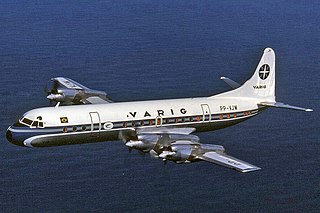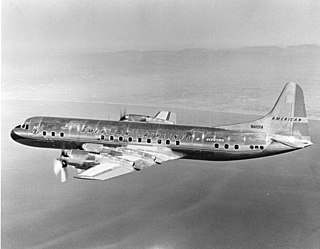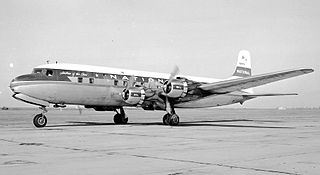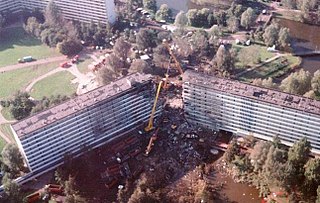
Aeroelasticity is the branch of physics and engineering studying the interactions between the inertial, elastic, and aerodynamic forces occurring while an elastic body is exposed to a fluid flow. The study of aeroelasticity may be broadly classified into two fields: static aeroelasticity dealing with the static or steady state response of an elastic body to a fluid flow, and dynamic aeroelasticity dealing with the body's dynamic response.

United Airlines Flight 232 was a regularly scheduled United Airlines flight from Stapleton International Airport in Denver to O'Hare International Airport in Chicago, continuing to Philadelphia International Airport. On July 19, 1989, the DC-10 serving the flight crash-landed at Sioux Gateway Airport in Sioux City, Iowa, after suffering a catastrophic failure of its tail-mounted engine due to an unnoticed manufacturing defect in the engine's fan disk, which resulted in the loss of many flight controls. Of the 296 passengers and crew on board, 112 died during the accident, while 184 people survived. 13 of the passengers were uninjured. It was the deadliest single-aircraft accident in the history of United Airlines.

The Lockheed L-188 Electra is an American turboprop airliner built by Lockheed. First flown in 1957, it was the first large turboprop airliner built in the United States. Initial sales were good, but after two fatal crashes that led to expensive modifications to fix a design defect, no more were ordered. With its unique high power-to-weight ratio, huge propellers and very short wings, large Fowler flaps which significantly increased effective wing area when extended, and four-engined design, the airplane had airfield performance capabilities unmatched by many jet transport aircraft even today—particularly on short runways and high field elevations. Jet airliners soon supplanted turboprops for many purposes, and many Electras were modified as freighters. Some Electras are still being used in various roles into the 21st century. The airframe was also used as the basis for the Lockheed P-3 Orion maritime patrol aircraft.

The Lockheed Model 14 Super Electra was an American civil passenger and cargo aircraft built by the Lockheed Aircraft Corporation during the late 1930s. An outgrowth of the earlier Model 10 Electra, the Model 14 was also developed into larger, more capable civil and military versions.

Pan Am Flight 214 was a scheduled flight of Pan American World Airways from Isla Verde International Airport in San Juan, Puerto Rico, to Friendship Airport near Baltimore, and then to Philadelphia International Airport. On December 8, 1963, the Boeing 707-121 serving the flight crashed near Elkton, Maryland, while flying from Baltimore to Philadelphia, after being hit by lightning. All 81 occupants of the plane were killed. The crash was Pan Am's first fatal accident with the 707, which it had introduced to its fleet five years earlier.

American Airlines Flight 320 was a scheduled flight between Chicago Midway International Airport and New York City's LaGuardia Airport. On February 3, 1959, the Lockheed L-188 Electra performing the flight crashed into the East River during its descent and approach to LaGuardia Airport, killing 65 of the 73 people on board. Weather conditions in the area were poor, which meant that the crew had to descend through dense clouds and fog. The aircraft flew lower than the pilots intended and it crashed into the icy river 4,900 feet (1,500 m) short of the runway at a speed of 140 knots. American Airlines had been flying the newly-developed Lockheed Electra in commercial service for only about two weeks before the accident.

National Airlines Flight 2511 was a United States domestic passenger flight from New York City to Miami, Florida. On January 6, 1960, the Douglas DC-6 serving the flight exploded in midair. The National Airlines aircraft was carrying 5 crew members and 29 passengers, all of whom perished. The Civil Aeronautics Board investigation concluded that the plane was brought down by a bomb made of dynamite. No criminal charges were ever filed, nor was the blame for the bombing ever determined, though a suicide bombing is suspected. The investigation remains open.

American Airlines Flight 157, a Douglas DC-6, departed on November 29, 1949, from New York City bound for Mexico City with 46 passengers and crew. After one engine failed in mid-flight, a series of critical mistakes by the flight crew caused the pilot to lose control of the plane during the final approach to a routine stopover at Love Field in Dallas, Texas. The airliner slid off the runway and struck a parked airplane, a hangar, and a flight school before crashing into a business across from the airport. 26 passengers and two flight attendants died. The pilot, co-pilot, flight engineer, and 15 passengers survived.
Northwest Airlines Flight 2 was a Lockheed Super Electra aircraft, registration NC17388, which crashed into the Bridger Mountains in Gallatin County, Montana, about twelve miles (20 km) northeast of Bozeman, on January 10, 1938. All ten on board were killed in the accident, which was the first fatal crash of a Lockheed Super Electra and of a Northwest Airlines aircraft.

Braniff International Airways Flight 352 was a scheduled domestic flight from William P. Hobby Airport in Houston, Texas, United States, to Dallas Love Field in Dallas; on May 3, 1968, a Lockheed L-188A Electra flying on the route, registration N9707C, broke up in midair and crashed near Dawson, Texas, after flying into a severe thunderstorm. It was carrying 5 crew and 80 passengers; there were no survivors. Among those killed was Texas state representative Joseph Lockridge, the first black man to represent Dallas County in the Texas Legislature. Investigation revealed that the accident was caused by the captain's decision to penetrate an area of heavy weather followed by a structural over-stress and failure of the airframe while attempting recovery from loss of control during a steep 180-degree turn executed in an attempt to escape the weather.

Eastern Air Lines Flight 375, registration N5533, was a Lockheed L-188 Electra aircraft that crashed on takeoff from Logan International Airport in Boston, Massachusetts, on October 4, 1960. Ten survived, nine with serious injuries, but 62 of 72 on board were killed in the accident. It remains the deadliest Bird strike in aviation history.

Northwest Orient Airlines Flight 710, a Lockheed L-188 Electra, disintegrated in-flight and crashed near Cannelton, Indiana on March 17, 1960. The flight carried 57 passengers and six crew members. There were no survivors.

The Grand Canyon mid-air collision occurred in the western United States on June 30, 1956, when a United Airlines Douglas DC-7 struck a Trans World Airlines Lockheed L-1049 Super Constellation over Grand Canyon National Park, Arizona. The first one fell into a canyon and the other one slammed into a rock face. All 128 on board both airplanes perished, making it the first commercial airline incident to exceed one hundred fatalities. The airplanes had departed Los Angeles International Airport minutes apart from each other and headed for Chicago and Kansas City, respectively. The collision took place in uncontrolled airspace, where it was the pilots' responsibility to maintain separation. This highlighted the antiquated state of air traffic control, which became the focus of major aviation reforms.

Imperial Airlines Flight 201/8 was a charter flight by the United States Army to transport new recruits to Columbia, South Carolina for training. On November 8, 1961, the aircraft crashed as it attempted to land at Byrd Field, near Richmond, Virginia. This was the second deadliest accident in American history for a single civilian aircraft.

TWA Flight 529 was a Lockheed Constellation L-049 propliner, registration N86511, operating as a scheduled passenger service from Boston, Massachusetts to San Francisco, California. On September 1, 1961, at 02:05 CDT, the flight crashed shortly after takeoff from Midway Airport in Chicago, killing all 73 passengers and five crew on board; it was at the time the deadliest single plane disaster in U.S. history.

On 4 October 1992, El Al Flight 1862, a Boeing 747 cargo aircraft of the Israeli airline El Al, crashed into the Groeneveen and Klein-Kruitberg flats in the Bijlmermeer neighbourhood of Amsterdam, the Netherlands. The crash is known in Dutch as the Bijlmerramp.

On April 4, 1955, a United Airlines Douglas DC-6 named Mainliner Idaho crashed shortly after taking off from Long Island MacArthur Airport, in Ronkonkoma, Islip, New York, United States.

American Flyers Airline Flight 280/D was a flight operated on a U.S. Military Air Command contract from Monterey Regional Airport in California to Columbus Airport in Georgia, via Ardmore Municipal Airport, Oklahoma. On April 22, 1966, while approaching Runway 8 at Ardmore, the aircraft overshot the runway and crashed into a hill, bursting into flames. Eighty-three of the 98 passengers and crew on board died as a result of the accident.

Air Manila Flight 702 was an unscheduled passenger flight from Naval Air Station Agana in Guam to Ninoy Aquino International Airport in Manila, carrying 33 passengers and 12 crew members; most of whom were personnel from the base. The Lockheed L-188A Electra attempted takeoff from runway 6L but crashed near a residential area; the crash was caused by retracting the flaps at an altitude too low to clear the terrain after the propeller of engine number three feathered. All 45 people on board and one person on the ground perished in the crash. The investigation concluded that the pilot should have followed company policy by aborting takeoff in the event of an engine failure before reaching VR (takeoff) speed.

On May 2, 2018, a Lockheed WC-130H transport aircraft of the Puerto Rico Air National Guard crashed in the US state of Georgia, shortly after departing from Savannah Air National Guard Base. The aircraft crashed on Georgia State Route 21 at 11:26 local time. All nine airmen were killed in the accident. All nine were members of the Puerto Rico Air National Guard.




















